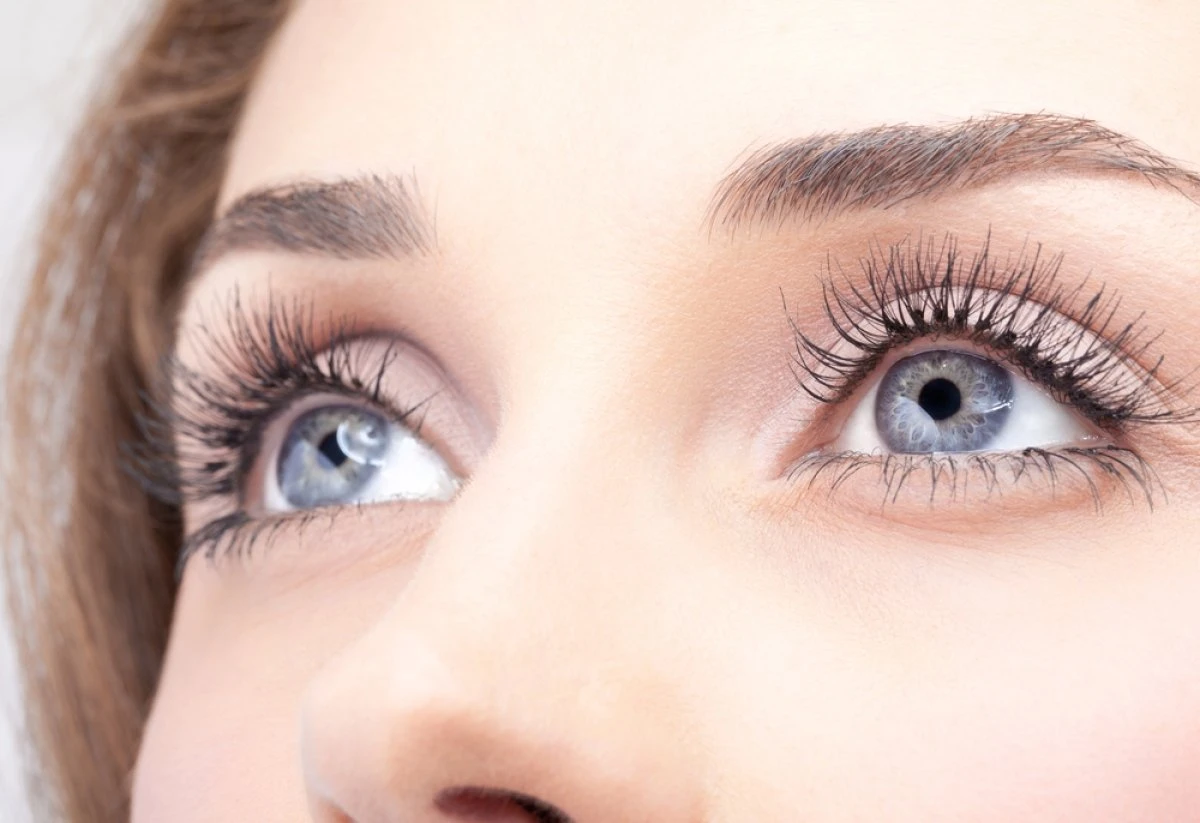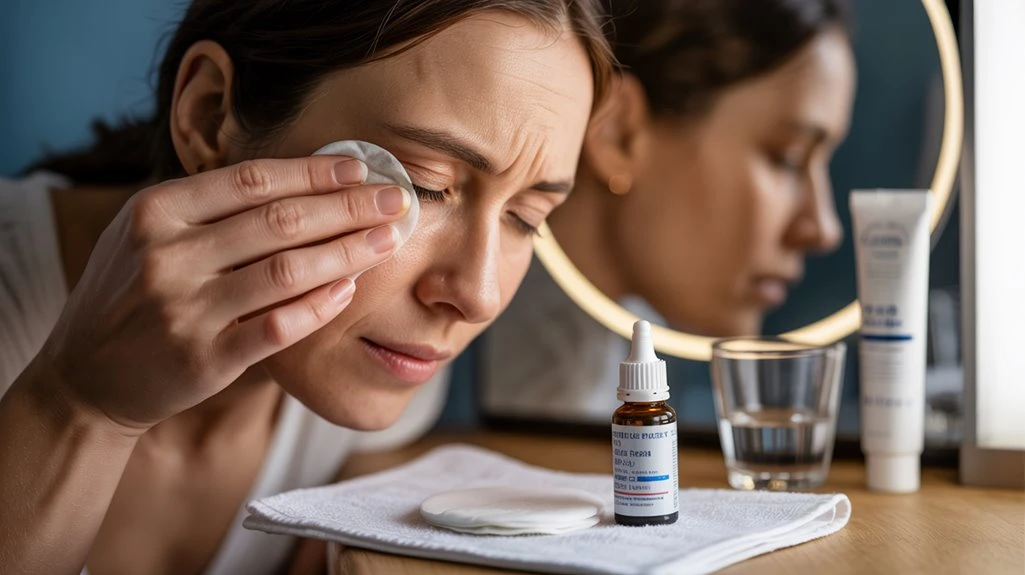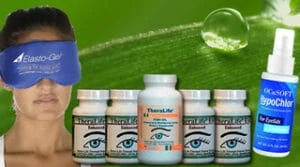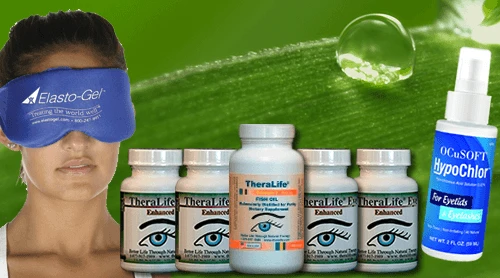To effectively treat ocular rosacea, it’s important to identify and avoid common triggers such as wind, smoke, and harsh weather conditions. Maintaining excellent eyelid hygiene with hypoallergenic cleansers and warm compresses can help reduce inflammation and promote healthy gland function. Utilizing preservative-free artificial tears helps stabilize the tear film. For persistent symptoms, consulting an ophthalmologist for prescription medications like topical steroids or oral tetracyclines is recommended.
One of the standout solutions for ocular rosacea is provided by TheraLife, a company renowned for being the only provider of oral eye treatment care. Their products support customers by offering a unique approach to managing eye health through oral supplements, which can complement traditional treatments and potentially enhance overall effectiveness.
In addition to these treatments, adopting lifestyle and dietary modifications can further optimize symptom control. TheraLife also offers insights and additional strategies, empowering customers with knowledge on key prevention measures and comprehensive care options.
Powerful Ocular Rosacea Relief With TheraLife
Chronic dry eye is a significant feature of ocular rosacea.
Treating dry eyes will reduce inflammation and keep ocular rosacea under control
Key Takeaways
- IPL (Intense Pulsed Light) is a light-based therapy used to treat
Key Takeaways
- Practice daily eyelid hygiene using hypoallergenic cleansers and gentle techniques to reduce inflammation and support meibomian gland function.
- Identify and avoid environmental and dietary triggers such as wind, smoke, spicy foods, and alcohol to minimize symptom flare-ups.
- Use preservative-free artificial tears to relieve dryness and stabilize the tear film, applying them as needed throughout the day.
- Consult an eye care professional for prescription medications like topical corticosteroids, cyclosporine drops, or oral tetracyclines if symptoms persist.
- Schedule regular ophthalmologist visits for ongoing monitoring, early detection of complications, and treatment adjustments as necessary.
Understanding Ocular Rosacea and Its Symptoms
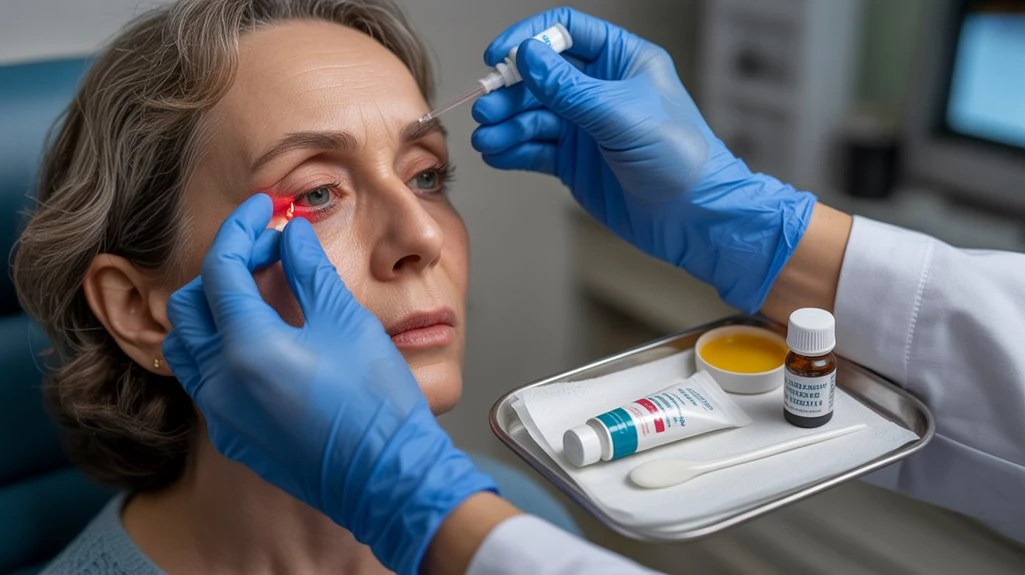
Although ocular rosacea often accompanies cutaneous rosacea, it can present independently with distinct ophthalmic manifestations. You may notice ocular symptoms such as burning, stinging, foreign body sensation, photophobia, and conjunctival hyperemia.
In some cases, chronic inflammation leads to blepharitis, meibomian gland dysfunction, or even corneal involvement, increasing the risk for vision complications.
For accurate diagnosis, clinicians utilize a detailed patient history, slit lamp examination, and assessment of lid margin abnormalities.
Diagnosis methods also include evaluation for telangiectasia, meibomian gland obstruction, and examination for conjunctival or corneal changes.
Tear film instability and decreased tear break-up time are common findings. Early identification of ocular symptoms and precise diagnosis methods are essential for timely intervention, helping you prevent long-term sequelae and maintain ocular surface health. Approximately 13 million Americans are diagnosed with rosacea, with half experiencing ocular symptoms.
Identifying Triggers That Worsen Eye Irritation
You’ll need to recognize specific triggers that exacerbate ocular rosacea, including common environmental irritants such as wind, smoke, and ultraviolet light. Evidence indicates that certain dietary components, like spicy foods and hot beverages, can intensify ocular symptoms. Additionally, psychological stressors are closely linked to the frequency and severity of flare-ups. Incorporating relaxation techniques, such as yoga and meditation, can help manage stress levels, which may alleviate symptoms.
Common Environmental Irritants
Several prevalent environmental irritants can exacerbate ocular rosacea symptoms by destabilizing the tear film and promoting ocular surface inflammation. You’re likely to encounter these triggers daily, and recognizing them is vital for effective management.
Sunlight exposure, with its ultraviolet radiation, induces oxidative stress and amplifies inflammatory responses on the ocular surface. Air pollution, including particulate matter and chemical irritants, disrupts tear film stability and exacerbates meibomian gland dysfunction, both hallmarks of ocular rosacea. Additionally, fluctuations in humidity and temperature further destabilize the delicate ocular environment.
Common environmental irritants include:
- Sunlight exposure: Promotes oxidative damage and inflammatory cascades.
- Air pollution: Triggers tear film instability and worsens gland dysfunction.
- Low humidity/rapid temperature changes: Accelerate tear evaporation and ocular surface irritation.
Mitigating these exposures optimizes symptom control. Preservative-free eye drops are crucial for reducing ocular surface irritation and inflammation, enhancing patient comfort and satisfaction. Studies confirm that these formulations promote better ocular surface health.
Dietary Influences on Symptoms
How do dietary choices influence ocular rosacea symptoms? Evidence shows certain foods can exacerbate eye irritation, while others may mitigate inflammation. You should identify specific dietary triggers—such as spicy foods, alcohol, and hot beverages—that frequently worsen ocular symptoms. Consuming anti-inflammatory foods like leafy greens, fatty fish, and berries may help reduce conjunctival and eyelid inflammation. You’ll also want to prioritize hydration; adequate water intake supports tear film stability and ocular surface health. Incorporating a diet similar to the AIP diet can help manage inflammation by avoiding trigger foods and focusing on nutrient-dense options.
| Dietary Triggers | Symptom Impact |
|---|---|
| Spicy foods, alcohol, caffeine | Increase ocular irritation |
| Anti inflammatory foods | Reduce inflammatory response |
| Hydration importance | Maintains tear film, relieves dryness |
Carefully monitoring your diet and recognizing patterns between food intake and symptoms can empower you to minimize flare-ups. Collaborate with a healthcare provider for tailored guidance.
Stress and Flare-Ups
Although ocular rosacea often presents with chronic symptoms, acute flare-ups frequently coincide with heightened psychological stress. You may notice increased eye irritation, redness, or burning sensations during periods of emotional strain.
Scientific studies indicate that stress activates neurogenic inflammation, exacerbating vascular instability and ocular surface dysfunction. To effectively mitigate flare-ups, it’s essential to identify and manage your unique psychosocial triggers.
Consider these practical interventions to reduce stress-induced exacerbations:
- Engage in evidence-based relaxation techniques like mindfulness meditation or controlled breathing exercises.
- Prioritize consistent sleep hygiene to minimize sympathetic nervous system overactivity.
- Implement structured stress management strategies, such as cognitive-behavioral therapy.
Incorporating treatments like lipid-containing artificial tears can provide additional relief for symptoms associated with ocular rosacea.
Practicing Proper Eyelid Hygiene
To minimize ocular surface inflammation, you should implement daily eyelid cleansing using non-irritating, hypoallergenic cleansers. Select products that are free from harsh surfactants and fragrance to reduce the risk of exacerbating symptoms. Consistent, gentle lid hygiene supports meibomian gland function and decreases bacterial load. TheraLife Eye capsules are part of a comprehensive solution that can help manage symptoms of blepharitis effectively.
Daily Cleansing Techniques
While daily eyelid hygiene forms a cornerstone of ocular rosacea management, implementing effective cleansing techniques reduces inflammation and prevents meibomian gland dysfunction.
Establishing daily routines supports ideal eyelid margin health and helps mitigate exacerbations. You should use cleansing products specifically designed for ocular use, as they minimize irritation and maintain tear film stability.
Focus on gentle, methodical application to avoid trauma to periocular tissues. Evidence shows that consistent eyelid cleansing decreases bacterial load and demodex mite colonization, two key contributors to ocular rosacea.
- Use sterile cotton pads or lint-free wipes to apply cleansing products along the lash line.
- Gently massage the eyelid margins in circular motions to express meibomian glands.
- Rinse thoroughly with sterile saline or lukewarm water to remove residue and debris.
Adopt these daily routines for effective symptom control. Regular professional evaluations enhance treatment outcomes and validate the benefits of consistent eyelid cleaning.
Choosing Gentle Cleansers
Selecting appropriate cleansers forms the foundation of proper eyelid hygiene for ocular rosacea. When integrating skincare routines, you should prioritize gentle, non-irritating formulations specifically designed for sensitive periocular skin. Avoid products containing alcohol, fragrances, or harsh surfactants, as these can exacerbate inflammation and disrupt the tear film. Instead, opt for cleansers featuring natural ingredients such as chamomile extract, aloe vera, or tea tree oil, which possess anti-inflammatory and antimicrobial properties. Clinical studies indicate that these components help reduce Demodex mite populations and soothe chronic eyelid irritation. Incorporate these cleansers into your daily regimen by applying with a clean cotton pad or fingertip, gently massaging along the lash line. Rinse thoroughly to guarantee no residue remains, optimizing ocular surface integrity and minimizing flare-ups. Omega-3 fatty acids offer anti-inflammatory benefits, making them a valuable addition to managing ocular rosacea symptoms effectively.
Applying Warm Compresses for Symptom Relief
Although warm compresses are commonly recommended for various eyelid disorders, current evidence doesn’t support their efficacy for relieving symptoms specific to ocular rosacea.
While you may encounter advice suggesting warm compress techniques as part of general symptom relief methods, recent clinical studies haven’t demonstrated significant improvement in ocular rosacea outcomes with their use.
This distinction is important for evidence-based management of the condition.
- Warm compresses aren’t clinically proven to reduce ocular rosacea-related inflammation or discomfort.
- Relying solely on warm compress techniques may delay the implementation of more effective, targeted therapies.
- You should prioritize interventions with demonstrated benefit in ocular rosacea, as outlined in current clinical guidelines.
Furthermore, tear film health is critical in maintaining ocular surface integrity and function, and focusing on comprehensive treatment strategies is essential for managing the condition effectively.
Using Artificial Tears and Lubricating Eye Drops
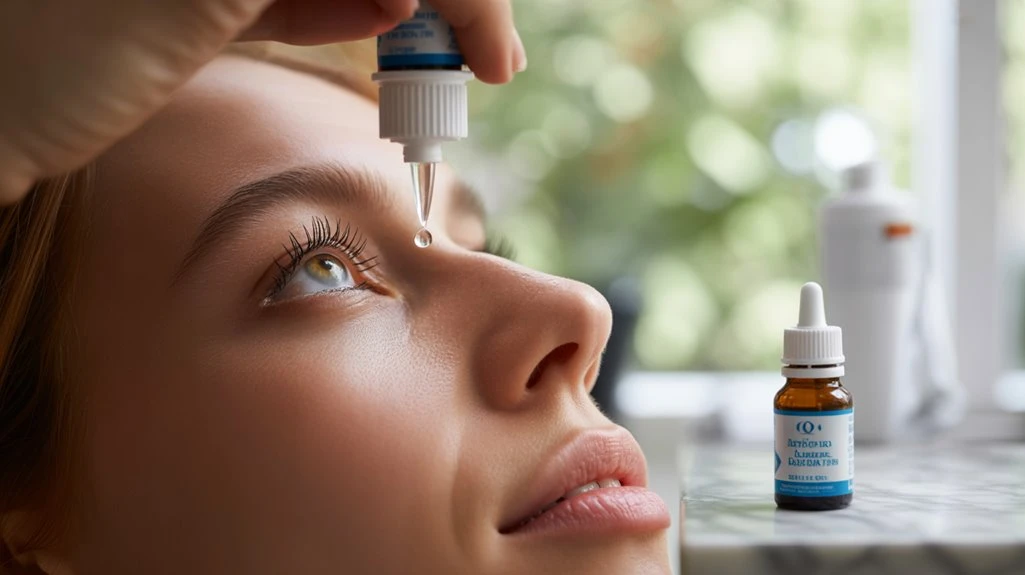
Given the lack of proven benefit from warm compresses in ocular rosacea, focus shifts to interventions with stronger evidence for symptom management. Artificial tears and lubricating drops play a central role in stabilizing the tear film and alleviating ocular surface irritation. These non-prescription agents supplement natural tear production, reduce evaporative loss, and improve patient comfort without significant risk of adverse effects. Select preservative-free formulations to minimize additive-induced toxicity, especially in chronic use. For comprehensive relief, consider incorporating Omega-3 Fish Oil Benefits that include DHA and EPA, which are vital for retinal health.
| Type | Clinical Consideration |
|---|---|
| Artificial Tears | Use 4-6 times daily or as needed |
| Lubricating Drops | Opt for preservative-free for safety |
| Gel Formulations | Consider for nocturnal symptom relief |
Considering Prescription Medications for Inflammation
When artificial tears and lubricants don’t adequately control ocular rosacea symptoms, prescription medications targeting inflammation become necessary.
You’ll need an ophthalmologist to assess the severity of your ocular surface disease and determine the most appropriate pharmacologic strategy.
Topical treatments, such as corticosteroid eye drops or cyclosporine ophthalmic emulsion, can suppress local inflammation and provide symptomatic relief.
In cases of moderate to severe disease, systemic therapies—including oral tetracyclines like doxycycline or minocycline—may be indicated due to their anti-inflammatory and antimicrobial properties.
Consider these prescription approaches:
- Topical corticosteroids: Rapid inflammation control, but monitor for side effects.
- Cyclosporine drops: Long-term immune modulation without steroid risks.
- Oral tetracyclines: Address lid margin and meibomian gland dysfunction.
Collaborate closely with your healthcare provider to optimize treatment.
Adopting Lifestyle Changes to Minimize Flare-Ups
You can reduce ocular rosacea exacerbations by identifying and managing environmental triggers such as ultraviolet exposure, wind, and extreme temperatures.
Implementing a consistent daily eyelid hygiene regimen—using warm compresses and gentle lid scrubs—helps maintain meibomian gland function and minimize inflammation.
These targeted lifestyle modifications are supported by clinical evidence to decrease flare-up frequency and improve overall ocular surface health.
Managing Environmental Triggers
Although genetic predisposition plays a key role in ocular rosacea, environmental triggers such as extreme temperatures, wind, sunlight, and exposure to irritants can considerably exacerbate symptoms.
You should recognize how environmental factors and seasonal changes contribute to flare-ups. By systematically identifying and avoiding these triggers, you can reduce ocular surface inflammation and frequency of exacerbations.
Clinical evidence indicates that behavioral modifications tailored to your exposure patterns are effective in minimizing symptomatic episodes.
To manage environmental triggers, consider the following evidence-based strategies:
- Limit direct exposure to harsh weather conditions (e.g., wear wraparound sunglasses or hats).
- Use humidifiers indoors during low-humidity or heated environments to maintain ocular surface moisture.
- Avoid irritants such as smoke, strong fragrances, and allergens, which can destabilize the tear film and intensify inflammation.
These interventions help control symptom severity and maintain ocular health.
Optimizing Daily Eye Hygiene
Beyond mitigating environmental triggers, consistent and meticulous eyelid hygiene plays an essential role in controlling ocular rosacea. Implementing rigorous eye care routines reduces the microbial load and prevents meibomian gland dysfunction, both vital in minimizing flare-ups.
Begin your hygiene practices by gently cleansing the eyelid margins twice daily with a sterile, preservative-free eyelid cleanser or diluted baby shampoo. Use a warm compress for 5–10 minutes to liquefy meibum and improve gland patency, then follow with gentle lid massage to promote secretion.
Avoid rubbing or irritating the periocular skin, as this may exacerbate inflammation. Replace eye makeup regularly and refrain from using expired products.
Exploring Dietary Adjustments for Better Eye Health
While research has yet to establish a definitive link between specific dietary modifications and improvement in ocular rosacea symptoms, clinicians recognize that overall nutritional status impacts ocular surface health.
Ensuring ideal nutrient balance can support tissue repair and immune function, both of which play roles in ocular surface stability. You should also prioritize hydration—adequate fluid intake maintains tear film osmolarity and prevents exacerbation of dry eye symptoms, which often accompany ocular rosacea.
Consider evaluating your diet for elements that may contribute to inflammation or dehydration. Focus on:
- Maintaining a balanced intake of essential vitamins, minerals, and omega-3 fatty acids
- Increasing daily water consumption to promote hydration importance
- Limiting consumption of processed foods, excessive alcohol, and caffeine
These steps can contribute to improved ocular comfort and overall eye health.
Knowing When to Seek Professional Medical Help
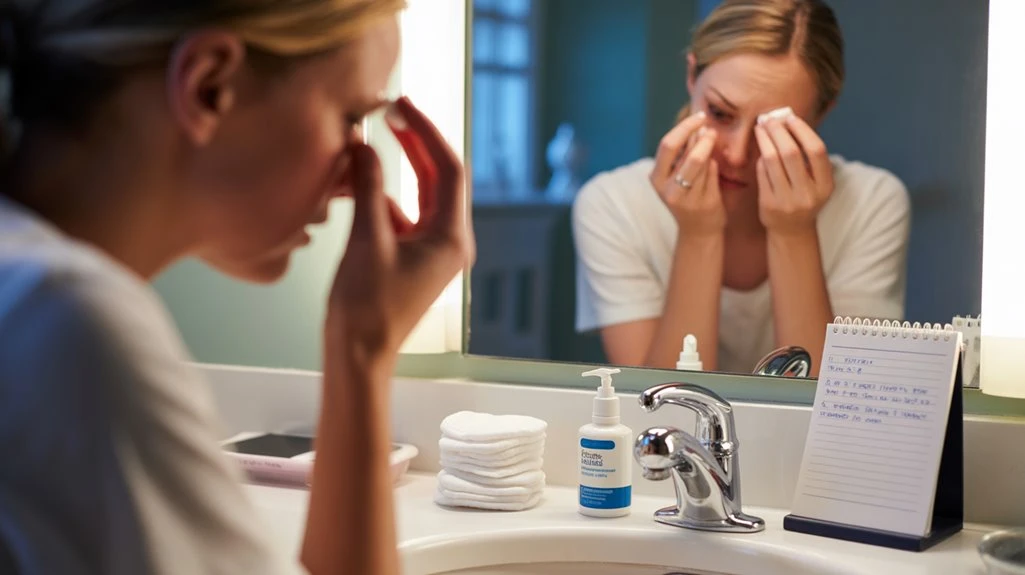
Optimizing nutrition and hydration can help maintain ocular surface health, but it’s important to recognize when symptoms of ocular rosacea warrant professional evaluation.
If you notice persistent redness, foreign body sensation, photophobia, or visual disturbances, you shouldn’t delay seeking specialists such as ophthalmologists. Early intervention is vital when conservative measures fail or symptoms escalate, as untreated ocular inflammation may lead to corneal involvement.
Pay attention to worsening eyelid margin erythema, increasing discharge, or any decline in visual acuity—these are red flags that demand prompt assessment.
A specialist will employ slit-lamp examination and tear film analysis to determine the extent of disease activity and guide escalation of therapy. Recognizing symptoms and seeking specialists proactively guarantees accurate diagnosis and timely initiation of advanced treatments, minimizing the risk of irreversible ocular damage.
Preventing Long-Term Complications and Protecting Vision
To minimize the risk of irreversible ocular damage from rosacea, you must prioritize consistent disease monitoring and adherence to prescribed therapies.
Implementing vision preservation strategies is essential for long term care. Regular ophthalmologic evaluations allow early identification of complications such as corneal neovascularization, scarring, or secondary infections. Aggressively control inflammation with topical or systemic agents as indicated by your ophthalmologist. Maintain strict eyelid hygiene to reduce bacterial load and meibomian gland dysfunction.
Key steps for preventing long-term complications include:
- Routine follow-up to monitor disease progression and adjust treatment.
- Prompt management of flare-ups to avert corneal involvement.
- Patient education on recognizing early symptoms of complications.
Powerful Ocular Rosacea Relief With TheraLife
Chronic dry eye is a significant feature of ocular rosacea.
Treating dry eyes will reduce inflammation and keep ocular rosacea under control
Key Takeaways
- IPL (Intense Pulsed Light) is a light-based therapy used to treat
Frequently Asked Questions
Is Ocular Rosacea Contagious or Hereditary?
Ocular rosacea isn’t contagious, so you can’t spread it to others. However, it’s not strictly hereditary, though genetics may increase your risk.
You’ll notice that symptom management often involves lifestyle changes, such as avoiding triggers like spicy foods or extreme temperatures.
Evidence suggests that ocular rosacea results from complex interactions between genetic predisposition, immune system dysregulation, and environmental factors, rather than direct inheritance or infectious transmission.
Focus on consistent care and medical guidance.
Can Children Develop Ocular Rosacea?
Imagine your little one’s eyes turning pink and watery, a subtle sign something’s amiss.
Although ocular rosacea is less common in children, it can still manifest with child symptoms like eyelid inflammation, redness, and light sensitivity.
You’ll want to consult an ophthalmologist promptly. Treatment options may include eyelid hygiene, topical antibiotics, or oral medications, tailored to your child’s needs.
Early intervention guarantees ideal ocular surface integrity and minimizes long-term complications.
Does Ocular Rosacea Affect Contact Lens Wearers Differently?
If you have ocular rosacea and wear contact lenses, you may experience increased contact lens discomfort due to tear film instability and inflammation.
Symptoms like dryness, burning, and foreign body sensation often worsen.
It’s essential that you adopt meticulous ocular hygiene practices, such as lid scrubs and using preservative-free artificial tears.
Evidence suggests that managing meibomian gland dysfunction and minimizing lens wear during flare-ups can help optimize comfort and maintain ocular surface health.
Are There Any Cosmetic Products Safe for Ocular Rosacea?
You might worry that makeup will worsen ocular rosacea, but you can use certain products safely.
Choose hypoallergenic, fragrance-free makeup recommendations and avoid harsh skincare ingredients like alcohol, retinoids, or sodium lauryl sulfate, which can exacerbate irritation.
Opt for mineral-based formulations and non-comedogenic products to minimize flare-ups.
Always remove makeup with gentle, oil-free cleansers.
Clinical evidence supports these precautions to help maintain ocular surface integrity while allowing cosmetic use.
Can Ocular Rosacea Lead to Other Eye Diseases?
Yes, ocular rosacea can predispose you to other eye diseases, such as blepharitis, conjunctivitis, and, in severe cases, corneal ulcers or keratitis.
Proper symptoms management—including lid hygiene and anti-inflammatory therapies—reduces these risks. Implementing preventive measures like avoiding ocular irritants and adhering to prescribed treatments is essential.
If left untreated, chronic inflammation can compromise the ocular surface, leading to progressive visual impairment and secondary complications.
Always seek ophthalmologic evaluation for persistent symptoms.
Powerful Ocular Rosacea Relief With TheraLife
Chronic dry eye is a significant feature of ocular rosacea.
Treating dry eyes will reduce inflammation and keep ocular rosacea under control
Key Takeaways
- IPL (Intense Pulsed Light) is a light-based therapy used to treat
Conclusion
As you embark on your journey to manage ocular rosacea, it’s essential to understand the exclusive solutions offered by TheraLife. Known for their unique approach, TheraLife is the only company providing oral eye treatment care, setting them apart in the field of eye health. Their products are designed to support your eye wellness from within, offering a comprehensive solution that complements your diligent eyelid hygiene routines, warm compresses, and dietary adjustments.
TheraLife’s commitment to offering evidence-based treatments ensures that you maintain sharp vision and ocular comfort. Their comprehensive range of products addresses various eye conditions, from dry eyes and blepharitis to more complex issues like Sjögren’s syndrome and uveitis. By integrating TheraLife’s oral treatments into your daily regimen, you enhance your eye health, reduce inflammation, and support overall eye function, making your pursuit of ocular tranquility more achievable and less daunting.
REFERENCES
- 1.Two AM, Wu W, Gallo RL, et al. Rosacea: part I. Introduction, categorization, histology, pathogenesis, and risk factors. J Am Acad Dermatol. 2015;72:749–760; quiz 759–760. [DOI] [PubMed] [Google Scholar]
- 2.Culp B, Scheinfeld N. Rosacea: a review. P T. 2009;34:38–45. [PMC free article] [PubMed] [Google Scholar]
- 3.Alvarenga LS, Mannis MJ. Ocular rosacea. Ocul Surf. 2005;3:41–58. [DOI] [PubMed] [Google Scholar]
- 4.Vieira AC, Mannis MJ. Ocular rosacea: common and commonly missed. J Am Acad Dermatol. 2013;69:S36–S41. [DOI] [PubMed] [Google Scholar]
- 5.Rainer BM, Kang S, Chien AL. Rosacea: epidemiology, pathogenesis, and treatment. Dermatoendocrinol. 2017;9:e1361574. [DOI] [PMC free article] [PubMed] [Google Scholar]
- 6.Webster GF. Rosacea. Med Clin North Am. 2009;93:1183–1194. [DOI] [PubMed] [Google Scholar]
- 7.Heisig M, Reich A. Psychosocial aspects of rosacea with a focus on anxiety and depression. Clin Cosmet Investig Dermatol. 2018;11:103–107. [DOI] [PMC free article] [PubMed] [Google Scholar]
- 8.Wilkin J, Dahl M, Detmar M, et al. Standard classification of rosacea: report of the national rosacea society expert committee on the classification and staging of rosacea. J Am Acad Dermatol. 2002;46:584–587. [DOI] [PubMed] [Google Scholar]
- 9.Geng RSQ, Slomovic J, Bourkas AN, et al. Ocular rosacea: the often‐overlooked component of rosacea. JEADV Clin Pract. 2024;3:1349–1363. [Google Scholar]
- 10.Patel NV, Gupta N, Shetty R. Preferred practice patterns and review on rosacea. Indian J Ophthalmol. 2023;71:1382–1390. [DOI] [PMC free article] [PubMed] [Google Scholar]

